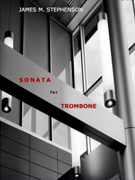Stephenson, James Sonata
Trombone Solos w/Piano

-
Stephenson, James
Sonata
21st Century (2004). Program Notes as written by Mark Hetzler:“Having known Jim since our time together as students in Boston, I have always marveled at the quality of his compositional technique as well as the creativity and inventive approach he takes with his craft. His Sonata is composed of three movements, each pitting contrasting themes and styles against each other, and together growing to form an overall and complete musical statement.
The first movement starts with a very slow and mysterious, blues-like ballad. The modern style of his musical voice can be heard immediately in the trombonist’s slippery first entrance (this piece is not afraid to reach outside of the traditional classical mold). Soon the opening music builds to an exciting climax and then turns reluctantly, easing back to set up the Tarantella, a very exciting romp showcasing triple tonguing, arpeggios, scale passages and a very dramatic inter-play between trombone and piano. The movement’s opening ballad material resurfaces after the tarantella’s energy is extinguished in a tumultuous outburst of descending major 7ths (a motive Jim returns to throughout the sonata).
The second movement is quite short, but it packs a wallop with its wild character and robust swagger. Subtitled “Homage to Prokofiev” (one of Jim’s favorite composers), this movement relies on very colorful melodies, a hilariously extroverted piano accompaniment and seemingly ridiculous statements shouted through the trombone.
The sonata keeps building with the final movement, a twisted Rondo form that again looks to wild energy to keep both players on their toes. The manic energy goes back and forth between pianist and trombonist for the entire movement, with the exception ofa very surreal interlude conveyed by a dream-like melody in the trombone over a hypnotic and somewhat impressionistic accompaniment in the piano.
Martha (Mark’s accompanist) and I have played Jim’s Sonata often over the past several years and, as our interpretation of the piece continues to grow, so does my sense of wonder and satisfaction with this work.
-
- Category: Trombone Solos w/Piano
- Item: 100949
- Grade/Level: Advanced
- Price: $30.00
-
(usually ships in 24 hours)
